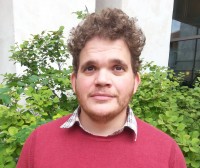This is the second in a series of interviews conducted by the Woodruff Library with the 2014-2015 Woodruff Library and Emory Center for Digital Scholarship (ECDS) Fellows. Funded by the Laney Graduate School School, the Woodruff Library and Emory Center for Digital Scholarship (ECDS) awards fellowships to advanced graduate students expecting to complete their dissertations by the end of the fellowship period. Fellows are placed within the Woodruff Library and ECDS to work in an area related to their subject specialization or interest, culminating in a formal presentation in the Spring.
An Interview with Ariel Svarch
Woodruff: Tell us a little bit about yourself. Where are you from? What’s your favorite book? What’s your favorite thing about Emory/Atlanta? Etc.
Ariel: I’m from Argentina and before I started graduate school, I worked as a journalist there for three years. My favorite author is Jorge Luis Borges, and my favorite American writer is Kurt Vonnegut. Following my national stereotype, I do dance the tango, but I am far from an excellent dancer. Nor am I great at soccer either, to be honest. Buenos Aires is a big, urbanized city, full of cement and tall buildings, so moving to Atlanta was a big cultural shock for me. However, I ended up loving the amount of foliage and the parks of my new home. I particularly love the way the city changes color during Fall and Spring. It is almost worth the allergies. My favorite thing about Emory is the sense of community and friendship with my fellow graduate students and also faculty and staff, not only from my department but also across the Laney Graduate School. I really value the collegiality and friendliness almost everywhere in our campus.
Woodruff: What are you researching for your dissertation?
Ariel: My dissertation, Four Jews, Five Identities: Representation, Popular Culture, and Language Politics in the Making of Jewish-Argentines (Buenos Aires, 1920-1945), focuses on the construction of hyphenated identities that combine national and ethnic components. I research the case of Eastern European Jewish immigrants and their descendants in Buenos Aires, and how different actors (Jewish and non-Jewish) tried to create and deploy Jewish-Argentine identities in the country’s public sphere. I examine popular culture; a reading of radio show monologs, parody song lyrics, comedic theater scripts, and comic strips allow me to identify cultural and linguistic (Yiddish-Spanish) hybridity and how different actors tried to define the limits of both Jewishness and Argentineness.
Woodruff: What interested you about the Woodruff Library Fellowship?
Ariel: As a historian, I welcomed the opportunity to learn more about the inner workings of a university research library. I have years of experience using an archive, but I had no idea of the process that transformed boxes of random papers and personal items into ordered, categorized, and assorted files. In all honesty, the amount of work that MARBL does for researchers goes well beyond what most Argentine archives do, and as a historian I value that deeply.
Woodruff: What will you be working on this year for your Woodruff Library Fellowship?
Ariel: This year I am joining the team working on “Revealing Her Story: Documenting African American Women Intellectuals.” It is a two-year project funded by the National Historical Publications and Records Commission to arrange and describe the personal papers of nine African American women writers, artists and musicians. I have already started on the material from teacher and composer Undine Smith Moore, which includes not only print and manuscript files, but also an extensive audiovisual collection. I am looking forward to starting work on cultural historian Delilah Jackson’s material. The MARBL team is great, and supportive with me as I learn by doing.

